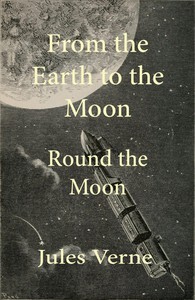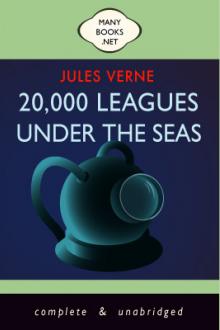The Moon-Voyage by Jules Verne (mobi ebook reader .txt) 📖

- Author: Jules Verne
Book online «The Moon-Voyage by Jules Verne (mobi ebook reader .txt) 📖». Author Jules Verne
Not only had he all the men for him, but the women too. What an infinite number of good marriages he might have made if he had taken a fancy to "settle!" Old maids especially dreamt before his portraits day and night.
It is certain that he would have found female companions by hundreds, even if he had imposed the condition of following him up into the air. Women are intrepid when they are not afraid of everything. But he had no intention of transplanting a race of Franco-Americans upon the lunar continent, so he refused.
"I do not mean," said he, "to play the part of Adam with a daughter of
Eve up there. I might meet with serpents!"
As soon as he could withdraw from the joys of triumph, too often repeated, he went with his friends to pay a visit to the Columbiad. He owed it that. Besides, he was getting very learned in ballistics since he had lived with Barbicane, J.T. Maston, and tutti quanti. His greatest pleasure consisted in repeating to these brave artillerymen that they were only amiable and learned murderers. He was always joking about it. The day he visited the Columbiad he greatly admired it, and went down to the bore of the gigantic mortar that was soon to hurl him towards the Queen of Night.
"At least," said he, "that cannon will not hurt anybody, which is already very astonishing on the part of a cannon. But as to your engines that destroy, burn, smash, and kill, don't talk to me about them!"
It is necessary to report here a proposition made by J.T. Maston. When the secretary of the Gun Club heard Barbicane and Nicholl accept Michel Ardan's proposition he resolved to join them, and make a party of four. One day he asked to go. Barbicane, grieved at having to refuse, made him understand that the projectile could not carry so many passengers. J.T. Maston, in despair, went to Michel Ardan, who advised him to be resigned, adding one or two arguments ad hominem.
"You see, old fellow," he said to him, "you must not be offended, but really, between ourselves, you are too incomplete to present yourself in the moon."
"Incomplete!" cried the valiant cripple.
"Yes, my brave friend. Suppose we should meet with inhabitants up there. Do you want to give them a sorry idea of what goes on here, teach them what war is, show them that we employ the best part of our time in devouring each other and breaking arms and limbs, and that upon a globe that could feed a hundred thousand millions of inhabitants, and where there are hardly twelve hundred millions? Why, my worthy friend, you would have us shown to the door!"
"But if you arrive smashed to pieces," replied J.T. Maston, "you will be as incomplete as I."
"Certainly," answered Michel Ardan, "but we shall not arrive in pieces."
In fact, a preparatory experiment, tried on the 18th of October, had been attended with the best results, and given rise to the most legitimate hopes. Barbicane, wishing to know the effect of the shock at the moment of the projectile's departure, sent for a 32-inch mortar from Pensacola Arsenal. It was installed upon the quay of Hillisboro Harbour, in order that the bomb might fall into the sea, and the shock of its fall be deadened. He only wished to experiment upon the shock of its departure, not that of its arrival.
A hollow projectile was prepared with the greatest care for this curious experiment. A thick wadding put upon a network of springs made of the best steel lined it inside. It was quite a wadded nest.
"What a pity one can't go in it!" said J.T. Maston, regretting that his size did not allow him to make the venture.
Into this charming bomb, which was closed by means of a lid, screwed down, they put first a large cat, then a squirrel belonging to the perpetual secretary of the Gun Club, which J.T. Maston was very fond of. But they wished to know how this little animal, not likely to be giddy, would support this experimental journey.
The mortar was loaded with 160 lbs. of powder and the bomb. It was then fired.
The projectile immediately rose with rapidity, described a majestic parabola, attained a height of about a thousand feet, and then with a graceful curve fell into the waves.
Without losing an instant, a vessel was sent to the spot where it fell; skilful divers sank under water and fastened cable-chains to the handles of the bomb, which was rapidly hoisted on board. Five minutes had not elapsed between the time the animals were shut up and the unscrewing of their prison lid.
Ardan, Barbicane, Maston, and Nicholl were upon the vessel, and they assisted at the operation with a sentiment of interest easy to understand. The bomb was hardly opened before the cat sprang out, rather bruised but quite lively, and not looking as if it had just returned from an aërial expedition. But nothing, was seen of the squirrel. The truth was then discovered. The cat had eaten its travelling companion.
J.T. Maston was very grieved at the loss of his poor squirrel, and proposed to inscribe it in the martyrology of science.
However that may be, after this experiment all hesitation and fear were at an end; besides, Barbicane's plans were destined further to perfect the projectile, and destroy almost entirely the effect of the shock. There was nothing more to do but to start.
Two days later Michel Ardan received a message from the President of the Union, an honour which he much appreciated.
After the example of his chivalrous countryman, La Fayette, the government had bestowed upon him the title of "Citizen of the United States of America."
CHAPTER XXIII. THE PROJECTILE COMPARTMENT.After the celebrated Columbiad was completed public interest immediately centred upon the projectile, the new vehicle destined to transport the three bold adventurers across space. No one had forgotten that in his despatch of September 30th Michel Ardan asked for a modification of the plans laid out by the members of the committee.
President Barbicane then thought with reason that the form of the projectile was of slight importance, for, after crossing the atmosphere in a few seconds, it would meet with vacuum. The committee had therefore chosen the round form, so that the ball might turn over and over and do as it liked. But as soon as it had to be made into a vehicle, that was another thing. Michel Ardan did not want to travel squirrel-fashion; he wished to go up head up and feet down with as much dignity as in the car of a balloon, quicker of course, but without unseemly gambols.
New plans were, therefore, sent to the firm of Breadwill and Co., of Albany, with the recommendation to execute them without delay. The projectile, thus modified, was cast on the 2nd of November, and sent immediately to Stony Hill by the Eastern Railway.
On the 10th it arrived without accident at its place of destination. Michel Ardan, Barbicane, and Nicholl awaited with the most lively impatience this "projectile compartment" in which they were to take their passage for the discovery of a new world.
It must be acknowledged that it was a magnificent piece of metal, a metallurgic production that did the greatest honour to the industrial genius of the Americans. It was the first time that aluminium had been obtained in so large a mass, which result might be justly regarded as prodigious. This precious projectile sparkled in the rays of the sun. Seeing it in its imposing shape with its conical top, it might easily have been taken for one of those extinguisher-shaped towers that architects of the Middle Ages put at the angles of their castles. It only wanted loopholes and a weathercock.
"I expect," exclaimed Michel Ardan, "to see a man armed cap-à-pie come out of it. We shall be like feudal lords in there; with a little artillery we could hold our own against a whole army of Selenites—that is, if there are any in the moon!"
"Then the vehicle pleases you?" asked Barbicane.
"Yes, yes! certainly," answered Michel Ardan, who was examining it as an artist. "I only regret that its form is not a little more slender, its cone more graceful; it ought to be terminated by a metal group, some Gothic ornament, a salamander escaping from it with outspread wings and open beak."
"What would be the use?" said Barbicane, whose positive mind was little sensitive to the beauties of art.
"Ah, friend Barbicane, I am afraid you will never understand the use, or you would not ask!"
"Well, tell me, at all events, my brave companion."
"Well, my friend, I think we ought always to put a little art in all we do. Do you know an Indian play called The Child's Chariot?"
"Not even by name," answered Barbicane.
"I am not surprised at that," continued Michel Ardan. "Learn, then, that in that play there is a robber who, when in the act of piercing the wall of a house, stops to consider whether he shall make his hole in the shape of a lyre, a flower, or a bird. Well, tell me, friend Barbicane, if at that epoch you had been his judge would you have condemned that robber?"
"Without hesitation," answered the president of the Gun Club, "and as a burglar too."
"Well, I should have acquitted him, friend Barbicane. That is why you could never understand me."
"I will not even try, my valiant artist."
"But, at least," continued Michel Ardan, "as the exterior of our projectile compartment leaves much to be desired, I shall be allowed to furnish the inside as I choose, and with all luxury suitable to ambassadors from the earth."
"About that, my brave Michel," answered Barbicane, "you can do entirely as you please."
But before passing to the agreeable the president of the Gun Club had thought of the useful, and the means he had invented for lessening the effects of the shock were applied with perfect intelligence.
Barbicane had said to himself, not unreasonably, that no spring would be sufficiently powerful to deaden the shock, and during his famous promenade in Skersnaw Wood he had ended by solving this great difficulty in an ingenious fashion. He depended upon water to render him this signal service. This is how:—
The projectile was to be filled to the depth of three feet with water destined to support a water-tight wooden disc, which easily worked within the walls of the projectile. It was upon this raft that the travellers were to take their place. As to the liquid mass, it was divided by horizontal partitions which the departing shock would successively break; then each sheet of water, from the lowest to the highest, escaping by valves in the upper part of the projectile, thus making a spring, and the disc, itself furnished with extremely powerful buffers, could not strike the bottom until it had successively broken the different partitions. The travellers would doubtless feel a violent recoil after the complete escape of the liquid mass, but the first shock would be almost entirely deadened by so powerful a spring.
It is true that three feet on a surface of 541 square feet would weigh nearly 11,500 lbs; but the escape of gas accumulated in the Columbiad would suffice, Barbicane thought to conquer that increase of weight; besides, the shock would send out all that water in less than a second, and the projectile would soon regain its normal weight.
This is what the president of the Gun Club had imagined, and how he thought he had solved the great question of the recoil. This work, intelligently comprehended by the engineers of the Breadwill firm, was marvellously executed; the effect once produced and the water gone, the travellers could easily get rid of the broken partitions and take away the mobile disc that bore them at the moment of departure.
As to the upper sides of the projectile, they were lined with a thick wadding of leather, put upon the best steel springs as supple as watch-springs. The escape-pipes hidden under this wadding were not even seen.
All imaginable precautions for deadening the first shock having been taken, Michel Ardan said they must be made of "very bad stuff" to be crushed.
The projectile outside was nine feet wide and twelve feet high. In order not to pass the weight assigned the sides had been made a little less thick and the bottom thicker, as it would have to
 Have you ever thought about what fiction is? Probably, such a question may seem surprising: and so everything is clear. Every person throughout his life has to repeatedly create the works he needs for specific purposes - statements, autobiographies, dictations - using not gypsum or clay, not musical notes, not paints, but just a word. At the same time, almost every person will be very surprised if he is told that he thereby created a work of fiction, which is very different from visual art, music and sculpture making. However, everyone understands that a student's essay or dictation is fundamentally different from novels, short stories, news that are created by professional writers. In the works of professionals there is the most important difference - excogitation. But, oddly enough, in a school literature course, you don’t realize the full power of fiction. So using our website in your free time discover fiction for yourself.
Have you ever thought about what fiction is? Probably, such a question may seem surprising: and so everything is clear. Every person throughout his life has to repeatedly create the works he needs for specific purposes - statements, autobiographies, dictations - using not gypsum or clay, not musical notes, not paints, but just a word. At the same time, almost every person will be very surprised if he is told that he thereby created a work of fiction, which is very different from visual art, music and sculpture making. However, everyone understands that a student's essay or dictation is fundamentally different from novels, short stories, news that are created by professional writers. In the works of professionals there is the most important difference - excogitation. But, oddly enough, in a school literature course, you don’t realize the full power of fiction. So using our website in your free time discover fiction for yourself. 




Comments (0)